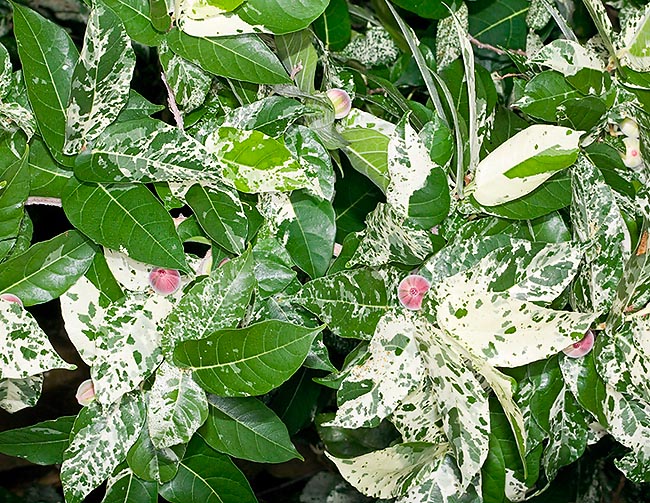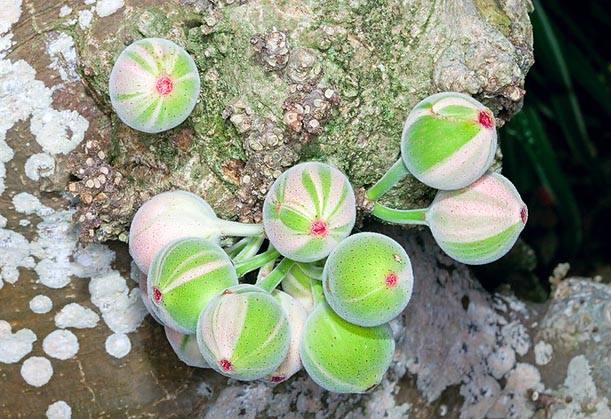Family : Moraceae

Text © Pietro Puccio

English translation by Mario Beltramini

Ficus aspera 'Parcellii' well deserves the English name of clown fig © Giuseppe Mazza
The name of the genus is the Latin one utilized for the common fig (Ficus carica); the Latin name of the species “aspera” = rough, refers to the foliar surface.
Common names: clown fig, mosaic fig, rough leale fig (English); higuera abigarrada (Spanish).
The Ficus aspera G.Forst. (1786) is a shrub or small evergreen tree up to 15 m tall, even if it keeps much lower when cultivated, with grey and smooth bark.
The leaves, on a short petiole, are alternate, simple, oblong or oval, 10-25 cm long and 8-12 cm broad, asymmetrical, with rough surface on both pages, of pale green or cream-white variegated colour, margins at times dentate and with sharp apex.
The inflorescences are syconia, that is hollows with fleshy walls entirely containing the flowers, accessible through an apical opening enclosed by tiny scales (typical example, that of the common fig, Ficus carica), carrying only either female flowers or male ones (dioecious species). The syconia, produced individually or in pairs at the axil of the leaves or directly on the main branches (cauliflory), on a short peduncle, are sub-globose, of 1-2,5 cm of diameter, pubescent, of initially green or white with green striae colour, then yellow or red with green striae when ripe, the inside is white.
For the fructification is indispensable the presence of the pollinating insect, as it is known, each species of Ficus is associated to a specific insect of the family of the Agaonidae, which, in turn, can reproduce only if the species of Ficus to which it is associated is present; the fruits (achenes) do contain one seed only.

Locally, the young leaves and the ripe fruits are eaten cooked © Giuseppe Mazza
The most cultivated form is the variegated one, known as Ficus aspera ‘Parcellii’, of great ornamental effect, cultivable in the tropical, subtropical climate zones, and, marginally, in the warm temperate ones, as it can resist, for a quite short time, to temperatures as low as -3 °C.
It requires a position in full sun, or partially shaded, in order to emphasize its variegations, soil rich of organic substance, draining, and regular irrigations in summer, but allowing the superficial layers of the soil to dry up before giving water again, reduced and moderate in winter, if necessary, especially with low temperatures, as it may be subject to radical rottenness in case of stagnating humidity.
It is cultivable in pot, for the decoration of inner spaces, in organic substratum with addition of coarse sand or agri-perlite around the 30%, in luminous position and temperatures, in winter, over the 14 °C. It is easily subject to mites’ attacks (red spider mite) and cochineals; it is therefore to be periodically checked in order to intervene quickly, if required.
Locally, the young leaves and the ripe fruits are consumed cooked as side dish.
Synonyms: Ficus parcellii Veitch ex Cogn. & Marchal (1874); Artocarpus cannonii Van Houtte (1875); Artocarpus laciniatus H.J.Veitch; (1875); Artocarpus exculptus W.Bull (1878); Ficus canonii (W.Bull ex Van Houtte) N.E.Br. (1888); Ficus aspera f. parcellii (H.J.Veitch ex Cogn. & Marchal) J.E.Burrows (2003).
